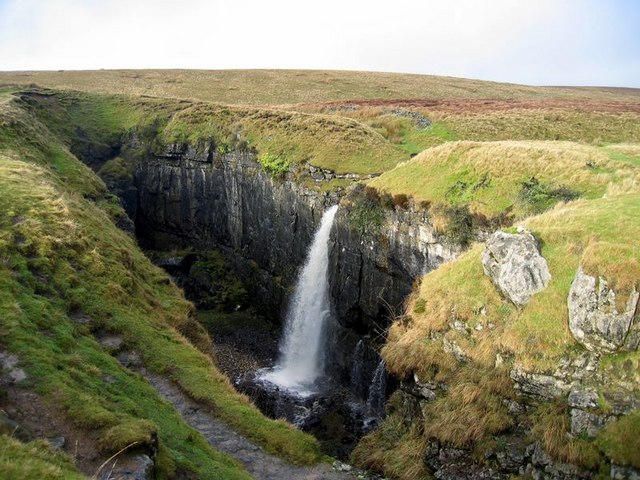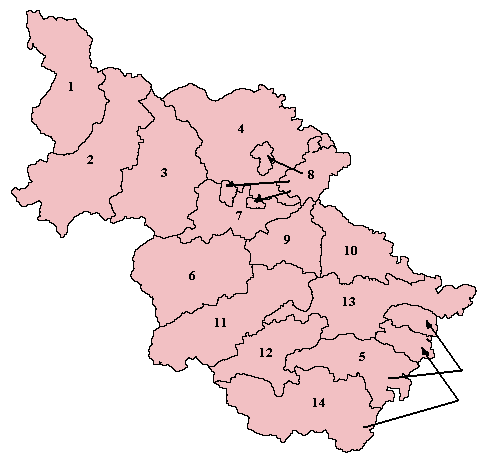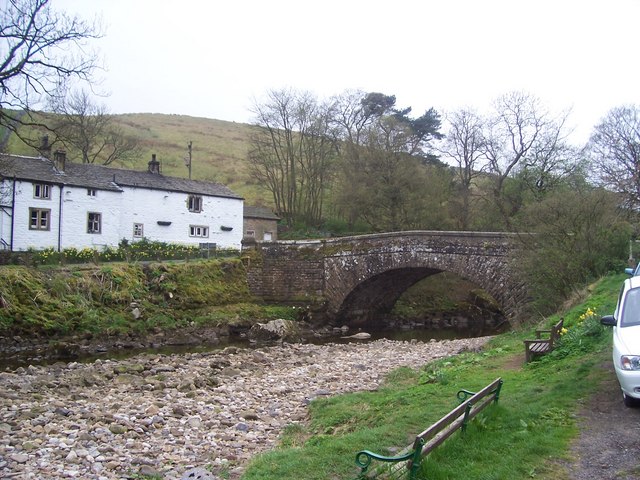|
Halton Gill
Halton Gill is a hamlet and civil parish in Littondale in the Yorkshire Dales in North Yorkshire, England. It is situated up Littondale from Litton. A minor road leads south west to Silverdale and Stainforth in Ribblesdale. The name of the hamlet was recorded in 1457 as Haltonghyll. The name derives from a combination of Old English and Old Norse and means the nook of land (or ravine) with a small valley by a farmstead and a stream. The civil parish includes the hamlets of Foxup and Hesleden. To the south the parish rises to the summits of Plover Hill and Pen-y-Ghent. The population of the civil parish was estimated at 60 in 2012. From Halton Gill there is a bridleway over the Horse Head Pass to the north east to Yockenthwaite in Langstrothdale. This path was used by the priest from Hubberholme to reach the small chapel in Halton Gill. To the west paths lead to the summit of Pen-y-ghent via Plover Hill. The 2010 Sainsbury's Christmas advert with celebrity chef, Jamie O ... [...More Info...] [...Related Items...] OR: [Wikipedia] [Google] [Baidu] |
Pen-y-ghent
Pen-y-ghent or Penyghent is a fell in the Yorkshire Dales, England. It is the lowest of Yorkshire's Three Peaks at ; the other two being Ingleborough and Whernside. It lies east of Horton in Ribblesdale. It has a number of interesting geological features, such as Hunt Pot, and further down, Hull Pot. The waters that flow in have created an extensive cave system which rises at Brants Gill head. In 2004 the body of Lamduan Armitage, dubbed by the media the "Lady of the Hills", was found near to the entrance of Sell Gill Hole. Etymology In the Cumbric language, exactly as in today's Welsh, ''pen'' meant 'top' or 'head', and ''y'' is most likely the definite article (''the''), exactly as in Modern Welsh ''y'' (compare Pen-y-berth 'end of the hedge/copse', or Pen-y-ffordd 'head of the road/way', etc.). The element ''ghent'' is more obscure, it could be taken to be 'edge' or 'border'. The name ''Pen-y-ghent'' could therefore mean 'Hill on the border' (compare Kent). Or else, the fi ... [...More Info...] [...Related Items...] OR: [Wikipedia] [Google] [Baidu] |
Hesleden, North Yorkshire
Hesleden is a hamlet in Littondale in the Yorkshire Dales in England. It lies within the civil parish of Halton Gill in the Craven district of North Yorkshire. Nether Hesleden is west of Litton, and Upper Hesleden is a further west, on the road from Halton Gill to Stainforth. The name is first recorded (as ''Eseldene'') in a charter of Fountains Abbey in about 1206. The name means "hazel valley", from the Old English Old English (, ), or Anglo-Saxon, is the earliest recorded form of the English language, spoken in England and southern and eastern Scotland in the early Middle Ages. It was brought to Great Britain by Anglo-Saxon settlers in the mid-5th c ... ''hæsel'' and ''denu''. References Villages in North Yorkshire {{NorthYorkshire-geo-stub ... [...More Info...] [...Related Items...] OR: [Wikipedia] [Google] [Baidu] |
West Riding Of Yorkshire
The West Riding of Yorkshire is one of three historic subdivisions of Yorkshire, England. From 1889 to 1974 the administrative county County of York, West Riding (the area under the control of West Riding County Council), abbreviated County of York (WR), was based closely on the historic boundaries. The lieutenancy at that time included the City of York and as such was named West Riding of the County of York and the County of the City of York. Its boundaries roughly correspond to the present ceremonial counties of West Yorkshire, South Yorkshire and the Craven, Harrogate and Selby districts of North Yorkshire, along with smaller parts in Lancashire (for example, the parishes of Barnoldswick, Bracewell, Brogden and Salterforth became part of the Pendle district of Lancashire and the parishes of Great Mitton, Newsholme and Bowland Forest Low became part of the Ribble Valley district also in Lancashire), Cumbria, Greater Manchester and, since 1996, the unitary East Riding of ... [...More Info...] [...Related Items...] OR: [Wikipedia] [Google] [Baidu] |
Staincliffe Wapentake
Staincliffe, also known as Staincliff, was a wapentake of the West Riding of Yorkshire. The wapentake was named from a place called Staincliffe, now lost, in Bank Newton, not to be confused with Staincliffe near Dewsbury. Staincliffe was presumably where the wapentake originally met, although in the 12th century it met at Flasby. The wapentake was split into two divisions. The East Division included the ancient parishes of Barnoldswick, Bracewell, Broughton, Burnsall, Carleton, Gargrave, Hebden, Keighley, Kettlewell, Kildwick, Linton, Marton in Craven, Skipton, Thornton in Craven and parts of Arncliffe and Addingham. The West Division included the parishes of Bolton by Bowland, Giggleswick, Gisburn, Kirkby Malhamdale, Long Preston, Slaidburn and parts of Arncliffe, Browsholme, Mitton, and Sawley. Some parts of the Forest of Bowland attached to the Chapelry of Whitewell, were part of the Lancashire parish of Whalley in neighbouring Blackburnshire Blackbur ... [...More Info...] [...Related Items...] OR: [Wikipedia] [Google] [Baidu] |
Arncliffe, North Yorkshire
Arncliffe is a small village and civil parish in Littondale, one of the Yorkshire Dales in England. Littondale is a small valley beside Upper Wharfedale, beyond Kilnsey and its famous crag. It is part of the Craven district of the non-metropolitan county of North Yorkshire, but is in the historic West Riding of Yorkshire. The population of the civil parish was estimated at 80 in 2015. Overview Situated on a gravel delta above the flood-plain of the River Skirfare, Arncliffe's houses, cottages, and other buildings face a large green, and green hillsides etched with limestone scars. A barn to the north of the green is a good example of the local style, with an unusual entrance, and a datestone of 1677. Behind the village buildings are several small crofts, nearly one to each house, and beyond these, limestone walls climb the surrounding hills separating higher fields. St Oswald's church lies close to the river a little north of the village, and the road up the dale crosses t ... [...More Info...] [...Related Items...] OR: [Wikipedia] [Google] [Baidu] |
Ancient Parish
In England, a civil parish is a type of administrative parish used for local government. It is a territorial designation which is the lowest tier of local government below districts and counties, or their combined form, the unitary authority. Civil parishes can trace their origin to the ancient system of ecclesiastical parishes, which historically played a role in both secular and religious administration. Civil and religious parishes were formally differentiated in the 19th century and are now entirely separate. Civil parishes in their modern form came into being through the Local Government Act 1894, which established elected parish councils to take on the secular functions of the parish vestry. A civil parish can range in size from a sparsely populated rural area with fewer than a hundred inhabitants, to a large town with a population in the tens of thousands. This scope is similar to that of municipalities in Continental Europe, such as the communes of France. However, ... [...More Info...] [...Related Items...] OR: [Wikipedia] [Google] [Baidu] |
Township (England)
In England, a township (Latin: ''villa'') is a local division or district of a large parish containing a village or small town usually having its own church. A township may or may not be coterminous with a chapelry, manor, or any other minor area of local administration. The township is distinguished from the following: *Vill: traditionally, among legal historians, a ''vill'' referred to the tract of land of a rural community, whereas ''township'' was used when referring to the tax and legal administration of that community. *Chapelry: the 'parish' of a chapel (a church without full parochial functions). *Tithing: the basic unit of the medieval Frankpledge system. 'Township' is, however, sometimes used loosely for any of the above. History In many areas of England, the basic unit of civil administration was the parish, generally identical with the ecclesiastical parish. However, in some cases, particularly in Northern England, there was a lesser unit called a township, being a ... [...More Info...] [...Related Items...] OR: [Wikipedia] [Google] [Baidu] |
The Woman In Black (2012 Film)
''The Woman in Black'' is a 2012 horror film directed by James Watkins from a screenplay by Jane Goldman. It is the second adaptation of Susan Hill's 1983 novel of the same name, which was previously filmed in 1989. The film stars Daniel Radcliffe, Ciarán Hinds, Janet McTeer, Sophie Stuckey, and Liz White. The plot, set in early 20th-century England, follows a young recently widowed lawyer who travels to a remote village where he discovers that the vengeful ghost of a scorned woman is terrorising the locals. The film was produced by Hammer Film Productions, Alliance Films, Cross Creek Pictures and the UK Film Council. A film adaptation of Hill's novel was announced in 2009, with Goldman and Watkins attached to the project. During July 2010, Radcliffe was cast in the lead role of Arthur Kipps. The film was meant to be shot in 3D before those plans were scrapped. Principal photography took place from September to December 2010 across England. Post-production lasted until Jun ... [...More Info...] [...Related Items...] OR: [Wikipedia] [Google] [Baidu] |
Hubberholme
Hubberholme is an old village in Upper Wharfedale in the Yorkshire Dales, North Yorkshire, England, at the point where Langstrothdale meets Wharfedale. It is quite secluded and the nearest village is Buckden. The village was a favourite place of writer and playwright J.B. Priestley who described it as the ''smallest, pleasantest place in the world''. The Norman church is the resting place of his ashes. The old inn, The George, is opposite the Church. This is notable for the lit candle that sits on the bar to indicate the pub is open and serving. The tradition dates from distinctive auctions for agricultural land or grazing that are still held in The George. The last bid to be received before the candle extinguished is the winner. The George Pub in Hubberholme opens throughout the year (with the White Lion at Cray and the Buck Inn at Buckden the closest alternative watering holes). After the George Inn, there is no pub on the Dales Way until the Sportsman Inn at Cowgill in C ... [...More Info...] [...Related Items...] OR: [Wikipedia] [Google] [Baidu] |
Langstrothdale
Langstrothdale is a scenic valley in the Yorkshire Dales in North Yorkshire, England. The uppermost course of the River Wharfe runs through it, but Wharfedale does not begin until the Wharfe meets Cray Gill, downstream of Hubberholme. The name Langstrothdale derives from Old English and translates as 'long marsh' or 'marshy ground'. The dale was first colonised by Anglians in the seventh century, with Norse invaders arriving later. In Norman times, many of the isolated settlements were allowed to remain, but were prevented from expanding by an arcane ruling known as the 'Forest Law'. At that time, Langstrothdale was well forested, and the upper northern part of the dale (which is now moorland) was a royal hunting forest known as Langstrothdale Chase or as the 'Forest of Langstroth'. The dale became part of the lands owned by the Clifford family and in 1604, due to the then Earl of Cumberland's 'extravagances', the lands were sold to pay off his debts. This allowed many Dalesfo ... [...More Info...] [...Related Items...] OR: [Wikipedia] [Google] [Baidu] |
Yockenthwaite
Yockenthwaite is a hamlet in the Craven district of North Yorkshire, England. It lies in the Langstrothdale valley in the Yorkshire Dales National Park. Historically part of the West Riding of Yorkshire, Yockenthwaite is north of Skipton and south of Hawes. The name of the hamlet is said to derive from ''Eoghan's clearing in a wood''. Yockenthwaite lies on the north bank of the River Wharfe. It is better known than may be expected because a children's television character from '' The Rottentrolls'' takes its name from the hamlet. The hamlet is connected to the road that winds up and down Langstrothdale by a grade II listed bridge from the early 18th century. This is the only route into and out of the hamlet via road transport. Yockenthwaite stone circle Just to the west of the village by Yockenthwaite Cave, are some ancient stones arranged in a circle. The stones, which are now a scheduled monument, are in diameter and believed to be Bronze Age in origin. The overall size ... [...More Info...] [...Related Items...] OR: [Wikipedia] [Google] [Baidu] |
Pen-y-Ghent
Pen-y-ghent or Penyghent is a fell in the Yorkshire Dales, England. It is the lowest of Yorkshire's Three Peaks at ; the other two being Ingleborough and Whernside. It lies east of Horton in Ribblesdale. It has a number of interesting geological features, such as Hunt Pot, and further down, Hull Pot. The waters that flow in have created an extensive cave system which rises at Brants Gill head. In 2004 the body of Lamduan Armitage, dubbed by the media the "Lady of the Hills", was found near to the entrance of Sell Gill Hole. Etymology In the Cumbric language, exactly as in today's Welsh, ''pen'' meant 'top' or 'head', and ''y'' is most likely the definite article (''the''), exactly as in Modern Welsh ''y'' (compare Pen-y-berth 'end of the hedge/copse', or Pen-y-ffordd 'head of the road/way', etc.). The element ''ghent'' is more obscure, it could be taken to be 'edge' or 'border'. The name ''Pen-y-ghent'' could therefore mean 'Hill on the border' (compare Kent). Or else, the fi ... [...More Info...] [...Related Items...] OR: [Wikipedia] [Google] [Baidu] |




